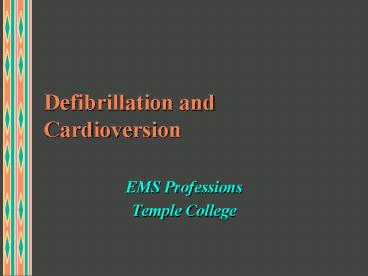Defibrillation and Cardioversion - PowerPoint PPT Presentation
1 / 18
Title:
Defibrillation and Cardioversion
Description:
The longer VF lasts, the harder it is to cure. The quicker the better. Shock early-Shock often ... Hypoxia, acidosis, hypothermia, electrolyte imbalance, drug ... – PowerPoint PPT presentation
Number of Views:5782
Avg rating:3.0/5.0
Title: Defibrillation and Cardioversion
1
Defibrillation and Cardioversion
- EMS Professions
- Temple College
2
Defibrillation
- Mechanism
- Current depolarizes myocardium
- Induces asystole temporarily
- Allows one pacemaker to regain control
3
Defibrillation
- Factors to consider
- Duration of VF
- The longer VF lasts, the harder it is to cure
- The quicker the better
- Shock early-Shock often
- Likelihood of resuscitation decreases 7-10 with
each passing minute
4
Defibrillation
- Factors to consider
- Myocardial environment/condition
- Hypoxia, acidosis, hypothermia, electrolyte
imbalance, drug toxicity impede conversion - Do NOT delay shock trying to correct problems
5
Defibrillation
- Factors to consider
- Heart size/body weight
- Pedi requirement lower than adult
- 2 J/kg initial shock
- 4 J/kg repeat shocks
- Direct size/energy relationship in adults unknown
- 200 to 360 J
6
Defibrillation
- Previous countershock
- Repeated shocks lower resistance
- Give three initial shocks in 30-45 sec
- One quickly after another with little time
between
7
Defibrillation
- Factors to consider
- Paddle size
- Adults (large paddles)
- 10-13 cm diameter
- Pediatric (small paddles usually lt 1 yr)
- Children 8 cm
- Infants 4.5 cm
8
Defibrillation
- Use largest size that completely contacts chest
without paddles touching - Small paddles concentrate current, burn heart
- Large paddles reduce current density
9
Defibrillation
- Paddle placement
- One to right of sternum below clavicle Other to
left of left nipple in anterior axillary line - Reversing paddles marked apex--sternum does NOT
affect defibrillation - AP placement can be used to defib small children
with adult paddles
10
Defibrillation
- Paddle-skin interface
- Cream, paste, saline pads, gelled pads
- Decreases resistance to current flow
- Avoid smearing or running bridges charge
- NEVER use alcohol!!!
11
Defibrillation
- Paddle contact pressure
- Firm pressure of 25 pounds
- Deflates lungs Shortens current path
- Do not lean on paddles They slip
12
Cardioversion
- Definitions
- Cardioversion
- Use of electrical shock to interrupt tachycardia
- Used in Non-Arrest patients only
- Only VF/VT (pulseless) can be defibrillated
13
Cardioversion
- Definitions
- Synchronized cardioversion
- Timing of shock to avoid peak of T-wave
- Prevents VF caused by delivering shock during
vulnerable period
14
Cardioversion
- Indications
- Tachyarrhythmias which
- Cause or worsen hemodynamic compromise
- Cause or worsen ischemic heart disease
- Are resistant to drug therapy
15
Cardioversion
- Procedure
- Oxygen, ECG monitor, IV
- Patient must be on leads to cardiovert
- Sedate with Valium or Versed
- Do NOT make patient unresponsive
16
Cardioversion
- Procedure
- Activate synchronizer
- Observe marking of complexes
- May need to unsynchronize if
- Random synching occurs
- Double-synching occurs
17
Cardioversion
- Procedure
- Charge to desired energy setting
- Depress buttons Hold until discharge occurs
- If VF occurs, unsynchronize before defibrillating
18
Cardioversion
- If a patient is in VF, why might the
defibrillator not discharge if the synchronizer
is on?






























